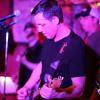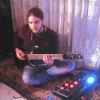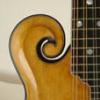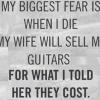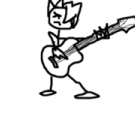Search the Community
Showing results for tags 'eq'.
-
Hello, I have had my Pod HD 500x for over 2 years and I am very happy with it. I have learned many things regarding the wonderful world of tech knowledge and effects. I have always been more of a player than a gear head. So my understanding of certain effects and specs is very limited. I run my Pod through my Soldano Lucky 13 Tube Amp and it sounds great on many of my tones. I am happy with my Blues Overdrive tones and clean tones. I even have a decent classic rock AC/DC sounding patch I created using a Plexi Lead Bright Amp. My downfall in tone creation is my limited understanding of Compressors, Noisegates, EQ, and things like that. My goal is to try to create a tight sounding Metal tone. I am looking for a Lamb Of God kind of sound (obviously I don't expect to play or sound like Mark or Willy from Lamb Of God) however, that is my desired style of tone. I have a pretty plain patch created where the only thing in the chain is the Treadplate amp with a good amount of drive and basic configurations of the amp knobs. It sounds good but it's lacking good sustain and it's not very clear when I play leads. It sounds muddy and I know I can change it but I am not sure where to start. I gave up on noisegates because it clips my leads when I try to sustain. I'd rather just deal with the amp buzz than sacrifice tone. My real question is about compressors. There's the blue comp, Red comp, Vetta Juice... I have zero clue what these do and how to use them but obviously they are useful because I see many people have them in their effects chains. What do each of them do? And where do I start? I know I am a total tech dummy but I figure the only way to learn is to ask people who do know and experiment with it. I noticed there is different types of EQ's I can use too. Why is that? I normally use Global EQ but my understanding of that is limited. Also where do I put these effects in my chain? Before or after the amp? Do add extra distortion to an already overdriven amp? I've seen people add overdrives to amp models that are already overdriven. It just sounds awful when I do it. But I assume there is a good way to do it. This piece of equipment is very deep in details and I do love it however, I find myself confused a lot. I figure I can also improve some of my current tones if I learn more about EQ and compressors. One of my biggest complaints with my Marshall tone is that there is hardly any sustain of my bends. The tone just goes flat. I am using a Gibson Les Paul and Gibson SG by the way. Thanks in advance for answers. I realize there is alot to answer in my post.
-
Hi all, new on here, but long time XTLive owner and now proud Helix man! Anyway, I have always loved the Kirk Hammett and Slash style wah, used a Vox Chrome for years and then the model of it on the XT. Generally happy with that, but given the flexibility of the Helix I now want more. I know there are the custom versions out there, but does anyone have any tips for thickening a wah sound, maybe with a graphic eq before then turning that block on as the wah is engaged??? Thanks in advance Ritchie
-
Is it possible to have a parametric eq straight after the guitar? I can use the Boost+EQ pedal, but that's not very flexible. I'd really like to be able have some high/low pass filters before anything else, but I can't work out how. Thanks
- 2 replies
-
- eq
- parametric
-
(and 3 more)
Tagged with:
-
Hi, I use the Helix in a dual rig situation (play guitar and bass, both in Return 1 & 2). I do it this way so the tuner works for both. ( I couldn't get the Guitar in and return 1 both use the tuner as an example. They are on separate paths yada yada. Anyway, when I'm not playing bass, I play guitar and the keyboard/harmonica player plays my bass etc. I tell this up front so you can get a sense on how I route things. It works awesome and has cut my 2 rigs down dramatically. The guitar is fine. But for bass, I go from the Helix with a few basic foundation effects. (Compressor/limiter, chorus, EQ) out to a Markbass Superbooster with the VLE (Vintage Loudspeaker Emulator) engaged on 6 (Out of 10). I go direct out from this XLR to FOH, and 1/4" to my bass amp which is set flat and more or less for stage monitoring. The Markbass creates a gritty jazz bass roundness and high end and low end rolloff to my Ibanez SR that I want to duplicate in the helix so I can shed this piece of gear as well (road worn and I expect it to start getting flaky and they don't make it anymore.) I can use the direct out ( Pre EQ) from my amp to take care of the FOH. So, I'm wondering if anyone knows this piece of gear and has tried to emulate it. On top of the rolloff, there is I think a slight bit of compression as well. While its a unique EQ, after all that I've done with the helix so far, I have to believe its absolutely possible to emulate. I'll be down to 1 lightweight class D amp, 2 instruments and the just the Helix if I can replicate this thing!
-
- bass patch
- eq
-
(and 1 more)
Tagged with:
-
I was trying to build a good dual amp setup with 2 x 5150 and when I tried to cut off some ugly high frequencies with the parametric EQ, the signal got distorted. Is this a bug? Can anyone give me a tip or tell me what am I doing wrong? Here is the patch: https://www.dropbox.com/s/jo6xl7hy6842rgr/Distorted%20signal.5xe?dl=0 Just turn on the parametric EQ and see what happens.
- 1 reply
-
- parametric eq
- 5150
-
(and 3 more)
Tagged with:
-
I took my HD500 in after upgrading it to 2.62 and measured the frequency responses of the Global EQ. I used an Audio Precision to generate a 100mV RMS signal into the Guitar input (set to Normal) and listen to the SPDIF output. I used a blank patch and panned Paths A/B to full L/R, respectively. Things aren't nearly as interesting as the FX EQs (plotted here for reference) because there are no % labels. Line 6 properly labeled the actual filter parameters and, based on my measurements, they did a pretty good job of getting them right. L/R balance is perfect. No surprises, although my measured Q was x2 what their label says. Not a big deal in my book. Still, attached here are half the graphs. Due to upload filesize limits I had to spread the plots out over two messages. The rest of the plots follow below.
- 31 replies
-
- 10
-

-
I have a pod hd pro and i downloaded the new metal hd pack today and basically i was trying out the new amps and when ever i put an EQ in the post area it goes all crackly sounding and lollipop. anyone know what this is?
-
Global EQ is used for compensating for the wide disparity in acoustic environments on tour or when traveling from studio to studio, and is applied to all setlists and presets. Global EQ features three fully parametric bands plus variable low and high cut filters. This feature is not available in the HD editor programs used via computer. To access Global EQ: Press and hold the VIEW button to open the Setup Menu. Using the four-way, cursor right until you see the Global EQ screen. Turn Knob 1 to select the desired EQ band (Low Cut, Low, Mid, High, High Cut) andturn Knobs 2, 3, and/or 4 to adjust the selected band. To bypass or enable Global EQ, press ENTER. NOTE—Due to L6 LINK’s flexible routing, Global EQ is not available at this output.
-
Global EQ preset onoff? Looking forward to the upcoming global EQ. Will it be possible to have it on or off per preset? Reason, now I use an external EQ in the loop used only for my acoustic guitar. Regards Lennart
-
I am having trouble cutting through the mix during my solos. I play in a 4 piece (drums, bass and 2 guitars) playing indie rock. I generally cut through just fine and in fact get regular comments from musos in the crowd complementing my tone. The problem comes in when I hit the 'solo button'. The result is either ear bleedingly loud or non existent. My rig is JTV 59 into an HD500 into an L3m. The nearest I have got to the boost I'm looking for is kicking in a screamer at the beginning of the chain to add a bit of grit, a studio eq after the mixer block with a 2db boost and a digital delay before the reverb. All these are turned on and off with one of the footswitches. What do you guys do to melt your audiences faces but keep their eardrums intact?
-
I run 2 main drive patches in my band, both pretty basic. The first one uses a Park model with moderate drive which works really well. My problem is that in a live situation my other main patch which is a Park with Tube Drive gets lost in the mix. I think the problem probably lies in the mids but I'd be really interested if anyone has some tips and/or settings using some of the HD500 EQs to cut through. Also, if you use an EQ where in the chain do you put it? Thanks guys.....
-
Hi! I recently got a used POD XT Pro and I am setting it up for live use. To do this, I got myself an FBV Shortboard MK I. I am looking to use the Compressor and EQ via footswitches, but clearly the Shortboard MK I doesn't support it [as far as I know]. Given this, I am now left to trigger them using CC #26 and CC #63 respectively. I would like to keep things simple, so I am looking at a simple 2-button MIDI footswitch that triggered either 0 or 127 [i.e. off and on] for each CC #. I was wondering if there is a MIDI footswitch that you could recommend for this purpose. I am not sure if this will help, but I also have an FBV 2 controller [the one with two switches for bank up/down]. I am curious if this could be configured to trigger the said CC numbers, as that will definitely help me save on costs. Thanks a lot guys!
-
Hi all, I feel obligated to point out that I'm new here, but also to defend myself by stating that I've had my Pod HD500 for quite a while now. Moving on For one of my seemingly simpler patches, I use a gated reverb at the core (screencap attached). After I dialed the noise gates in and all, it sounded ideal, but only on mid-low-range notes, to which I tailored the gates. When I play some high notes, the noise decays differently, so the effect is not quite uniform. My question is: is there any way I can have separate noise gates for high frequencies and low? I'm starting to think more EQ's, one on each leg of the split channels, might have something to do with it. Is my brain simply spacing out on something simple, or is what I'm trying to do impossible? Thanks a million for reading my pleas, and a million+1 if you help me out :D
-
Hello all Is there any way to keep the lcd screen showing the position of the knobs instead of the preset name when operating the amp? When playing live, and especially when using the venue's cab you have to tweak the EQs of each preset for the venue..and time for soundcheck is not always ideal... As a result sometimes you just have to fine-tune EQs on the fly in the first songs, but this is very difficult since you dont know the actual position of each EQ for the current preset. For example, if you want to add a liitle bass, the actual bass knob may be at 12 o'clock but the preset position may be at 9, so in order to add a little bass you have to roll the bass knob down (provided you remember that it was initially set at 9)...confusing eh? If you could see the preset knob position in the lcd screen you'd take this as your basis and know what to do.. Manual mode is a good work-around if you only play with one preset OR if you only use one amp simulation. I'm sure I'm not the only one with this problem.. Alternativelly, is there any way of bringing the position of the virtual knobs on screen without changing any of the EQs or volume? Thanx in advance.. PS. I know this has been mentioned in other topics, but no solution has been given and I find it to be a major issue, so I decided to open a dedicated topic on this.
- 1 reply
-
- spider valve
- presets
-
(and 2 more)
Tagged with:
-
Hello, I'm a bit of a noob and quite new to amp modeling. Does anyone know what EQ this patch http://line6.com/customtone/tone/211405/ has? I'm curious because I recently became a Scott Pilgrim fan. I don't have the full version of POD Farm so I can't get the settings at all. Any help? Sex Bob-omb.L6T.l6t
- 1 reply
-
- line 6
- sex bob-omb
-
(and 3 more)
Tagged with:
-
Had a patch that was boomy as hell with my JTV59 Variax into my POD HD500, regardless of the guitar model it seemed. The patch itself was a dual tone, comprised of a Bright Channel Plexi and Normal Channel Deluxe. A 63 Spring Reverb and Bias tremolo were pushed into both amps and a volume pedal at the beginning of the chain. I screwed with amp parameters til I was nearly frustrated, and then thought "EQ the signal in". So I put a studio EQ right after the volume pedal and adjusted down the low signal going in and Viola! Makes me wonder what else EQ can do for things elsewhere now...
-
After seeing the interest expressed in my EQ frequency responses, I decided to take the HD500 back into the lab to measure gain. How much gain is there from the various inputs? How much gain thru the various EQ (my previous post lists some of that)? Perhaps look at gain thru some of the FX? Or maybe I shouldn't look at gain. I am soliciting other ideas to look at while I have it in the lab. Do any of you have any ideas?
- 1 reply
-
- hd500
- measurements
- (and 5 more)
-
So where is everyone placing the Eq's in the chain. Ie before or after the amp. Which seems to work best for you?
-
I was wondering whether I can somehow apply 'global settings' to ALL presets of my HD500, that is adjust EQ in such a way that affects every single patch. Roland VG99 offers such adjustment which makes it possible to adjust all presets on ever changing live stage environments. Thank you in advance for helping!
-
-
-
- m20d
- stagescape
- (and 8 more)
-

VIDEO: Channel Strip Part I: Eq/Tweak Pads/Global FX
Line6Tony posted a article in StageScape M20d Mixer
-
- stagescape
- m20d
-
(and 6 more)
Tagged with:
-
Have you ever had this happen to you? You've spent the afternoon getting all your sounds perfectly tweaked for tonight's gig, but when you get there and start playing, everything sounds really..... not right? Things sound overly bright, but also a little 'woofy', so you have to fix things on the fly as the night goes along and silently curse your amp. The next day, when you set things back up at home, you go back to re-tweak your sounds, and suddenly they sound okay again. Are you going nuts? Have your ears suddenly lost it? Is there a problem with your amp? Don't worry, they're both fine; you've just been bitten by the Fletcher-Munson curves. "What's this?", you ask. "I thought Thurman Munson was a catcher for the Yankees, not a pitcher, (although he hit the curve pretty well) and who the heck is this Fletcher guy?" Well, aside from the fact that the baseball trivia part of your brain is functioning just fine, there's a whole other story going on here. Although it may look a little daunting (especially that graph you see looming below), it's really pretty simple, so just bear with us a moment for the inside poop. Fletcher and Munson were researchers at Bell Laboratories who demonstrated, in 1933, that the human ear (and brain) perceive different frequencies in a shifting manner dependent on level. Their measurements showed that your ear is most sensitive to frequencies in the range of 3-4kHz, and that frequencies above and below those points must be louder, in absolute terms, in order to be perceived as being of equal loudness. They also showed that the amount of increase of loudness in those other frequencies to achieve that perceived equality varies depending on what the overall SPL (Sound Pressure Level), or sound intensity, is in the first place. These discoveries helped kick off a whole new area of study called 'psychoacoustics' and brought you, among other things, that little button on your stereo labeled 'Loudness'. When they mapped our these curves (also known as 'Equal Loudness Contours') they looked something like this: When you look at these curves, you'll notice that when the 3-4 kHz range is at 0dB (or just barely audible), frequencies at 20Hz (about as low as you can perceive a distinct tone) have to be raised over 60 dB (which is 64 times as loud. Remember that decibels are measured on a logarithmic scale, so this is also 1000 times the power) to be perceived as being the same volume. On the other hand, when the base level for our 'home' frequencies is raised to 80dB, the lowest frequencies only have to be raised 10dB (or be twice as loud) to be perceived as being the same volume. Now what does this mean to you as a guitarist? Well, as we alluded to above, you'll notice that the curves flatten out substantially as you get louder. This means that the sounds you tweak up in your living room will have the low and high end boosted substantially (the infamous 'smile curve') to make those frequencies sound equally loud to the midrange frequencies to which you're most sensitive. When you take those sounds that you designed at around 60-70 dB (which is your basic living room, not gonna wake the neighbors or overly annoy the family level) and turn them up to the average 90dB+ stage levels, those same high and low frequencies will suddenly seem overly exaggerated making everything sound simultaneously painfully bright, yet woofy (kinda like a bad wine tasting description). Not only that, but those midrange frequencies (where the fundamental information about just which note you're playing live) are being overwhelmed by that, now excessive, high and low frequency information. So what's a fella to do? Well, if you can manage it without driving everyone crazy, studies have determined that the optimum level for reference mixing (which would apply to sound design as well) is about 85dB. This is loud enough to start flattening out the curve, but not so loud as to seriously hurt yourself (unless you do it for 14 hours straight) Get yourself an inexpensive SPL meter, set it to 'A' weighting (which shoots for the equivalent of the human hearing sensitivity) crank up your amp so you're averaging 85dB, and tweak in your patches. Of course, 85dB is, to put it in easily understandable terms, 'pretty darn loud', so this isn't something you can do a 2 AM when you can't sleep 'cause you're worrying about sounding just right for the next gig. The next best thing is to schedule a rehearsal with the rest of your band where you can crank it up, and make your final tweaks while the rest of the guys are there cracking jokes about obsessive/compulsive guitarists. Your third option, and probably the easiest, is to study the curves above carefully, and remember that if your sound is a little mid-heavy and seems a little bit dull at living room level, it's probably going to be about right when you crank that sucker up live. Here's a potential approach. Next time you're tweaking up a tone or two, make two versions; one that sounds right at living room levels, and one that you think, using the stuff you've learned here, should sound about right at stage levels. When you play live, leave the first one alone, and tweak the second one (if necessary), then go back the next day and compare the two. Pay attention to how they differ from each other. Now try and make a couple more, using the same process. After you've done this a few times, you should be getting a pretty good feel for just what you'll have to do to get 'em right the first time. Presto, you're one step closer to that elusive Ph.D in Tone. Now, if you're the type that really wants to dive in and get some serious information overload, you might want to try going here. This is one of the coolest online reference sites we've found in a long time, courtesy of Campanella Associates, an acoustic consulting firm. It's a fairly complete audio text and tutorial, that will give you more than you thought you needed to know (but not more than you should) about audio, acoustics, and sound.
